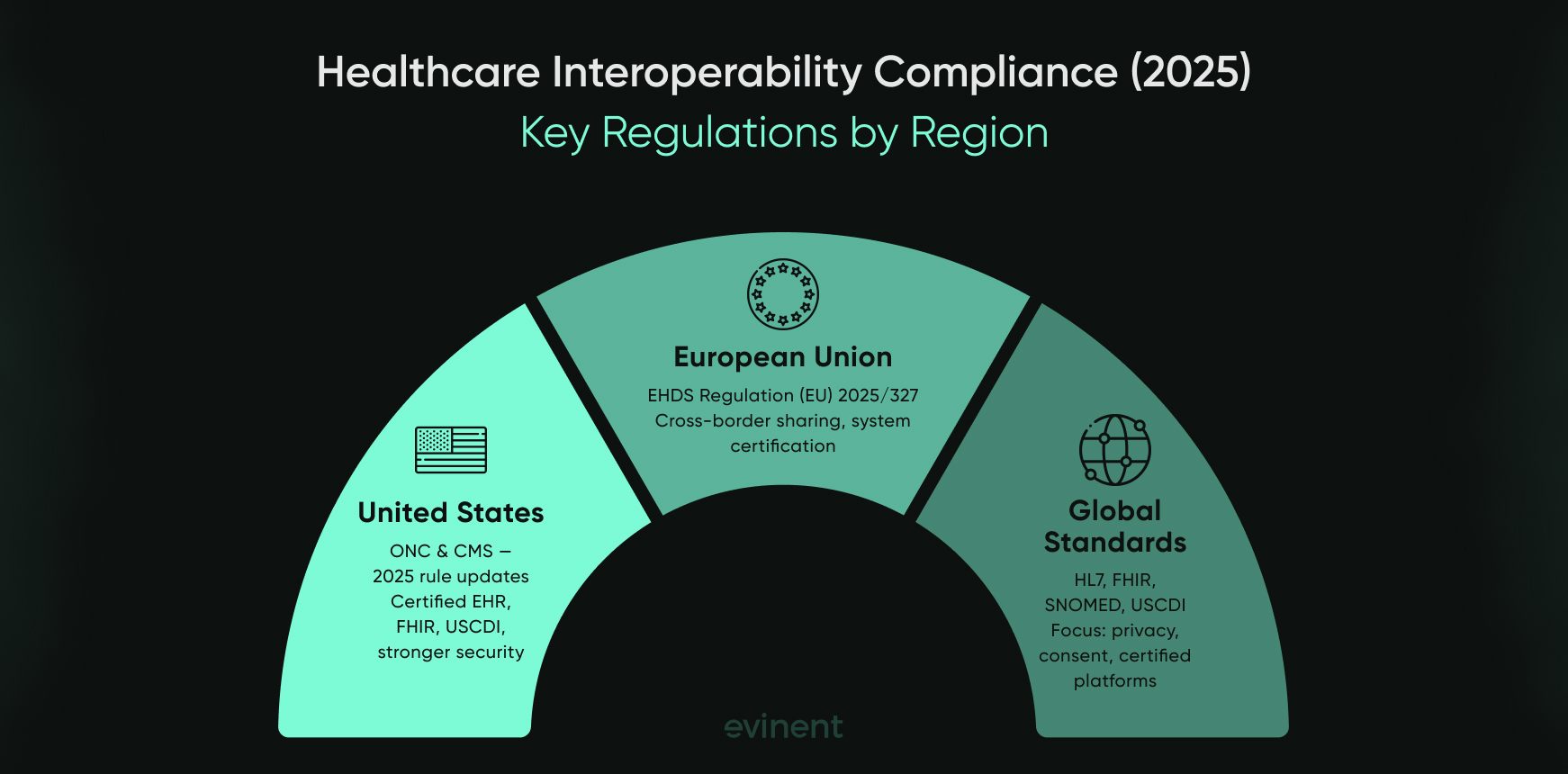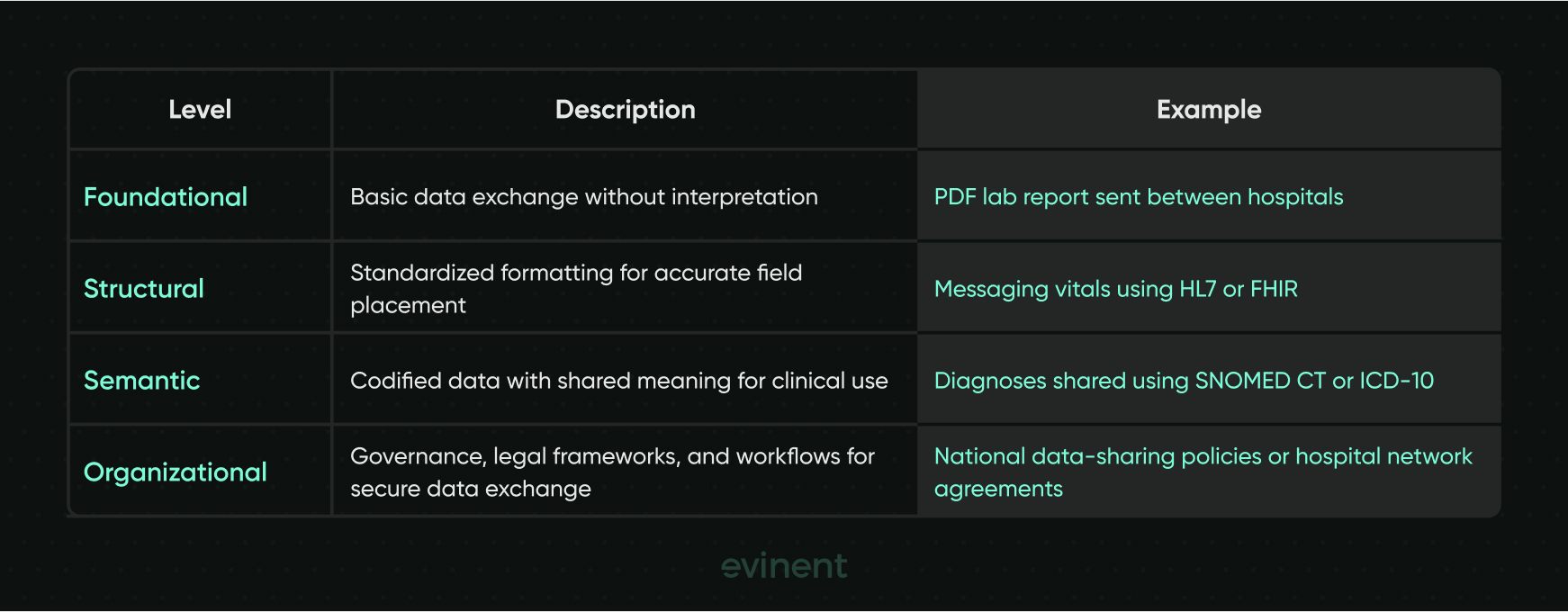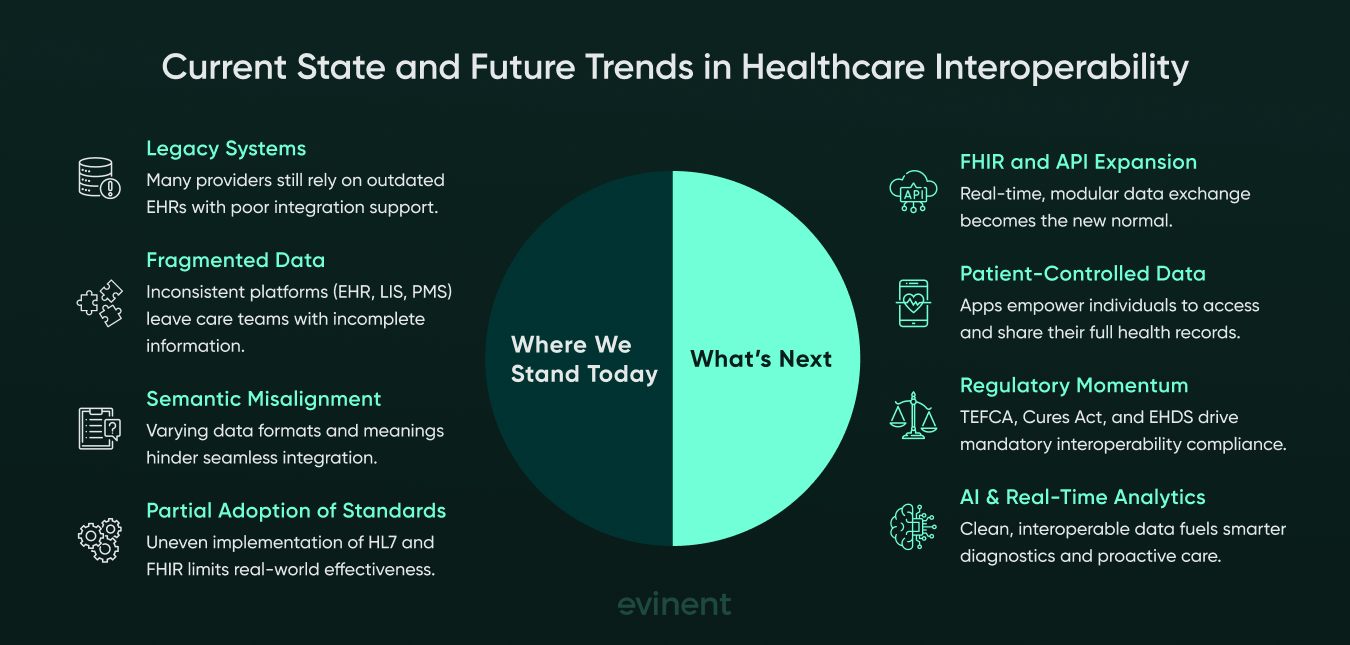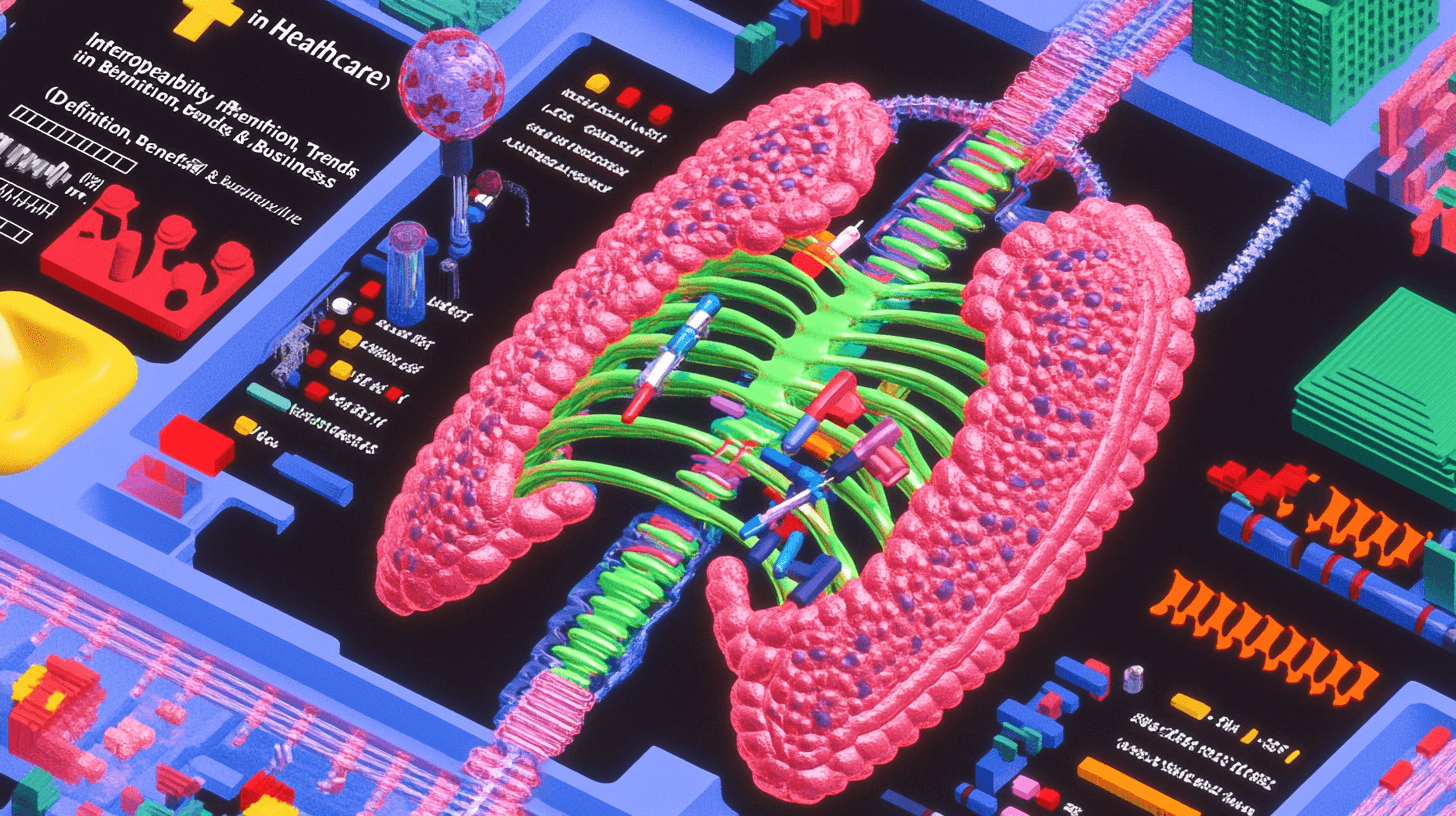Picture this: You visit your primary care doctor for a routine checkup, get referred to a specialist for further evaluation, and later head to a separate lab for testing — all in the same month. Now imagine every provider you interact with has real-time access to your full medical history: test results, medications, prior diagnoses, even allergy s. No duplicate questions. No lost records. No gaps in care.
That’s what interoperability in healthcare makes possible.
In 2025, interoperability isn’t just a tech neologism — it’s the connective tissue of modern medicine. It allows healthcare information systems, devices, and applications to exchange and interpret data securely and instantly, no matter where that data originates. And that shift changes everything.
For patients, it means safer care and fewer mistakes. Studies show that providers with access to external health data see fewer emergency escalations, thanks to timely and accurate clinical insights. Missed diagnoses, dangerous medication overlaps, and forgotten follow-ups become far less likely.
For providers, it enables true care coordination. With chronic conditions on the rise and more patients seeing multiple specialists, interoperable networks — like Health Information Exchanges (HIEs) — ensure every member of a care team is working with the same, up-to-date information. That continuity improves outcomes and reduces friction at every touchpoint.
And when seconds matter? Real-time data exchange can make all the difference. Whether it's an emergency vehicle transmitting vitals to a hospital before arrival, or remote monitoring devices flagging abnormalities for immediate response, interoperability supports faster, more informed interventions.
But the benefits don’t stop at the bedside. For healthcare systems, interoperability also means efficiency and cost savings. Redundant tests are eliminated. Administrative tasks like data entry and prescription routing are automated. Staff are freed up for meaningful work — not hunting down records.
Patients, too, are gaining power. Thanks to initiatives like the U.S. Interoperability and Patient Access Final Rule, people can now view their complete medical history across providers in a single app. That transparency enables smarter decisions, second opinions, and greater trust in the system.
And let’s not forget innovation. When diverse, high-quality datasets can be accessed securely and ethically, interoperability fuels medical research, AI development, and better public health policy.
In short, interoperability is the infrastructure for connected care — and it’s fast becoming the standard, not the exception.
What Is Interoperability in Healthcare?
Let’s keep it simple: interoperability in healthcare means that different systems, software, and devices can not only exchange data — but actually make sense of it — without requiring manual effort.
Think of it as a universal translator for healthcare IT. From electronic health records (EHRs) and lab systems to pharmacy platforms, imaging tools, wearable devices, and insurance databases, interoperability enables all of them to access, exchange, and use information securely and consistently.
This interoperability in healthcare definition includes not just technical connectivity but also the ability to interpret and act on exchanged data across multiple platforms — often referred to as healthcare data interoperability or data interoperability in healthcare.
In practical terms? Your health data follows you — not just your file number. Whether it’s your cardiologist pulling up test results from a primary care visit, or a hospital sharing discharge instructions with a rehabilitation clinic, interoperability ensures everyone has the same up-to-date picture.
The result: better care coordination, fewer medical errors, faster interventions, and more empowered patients. It’s the foundation for modern, patient-centered care — and it’s redefining how healthcare works in 2025.
Challenges and Barriers of Interoperability in Healthcare
On paper, healthcare interoperability sounds like a no-brainer. Who wouldn’t want seamless data sharing, fewer errors, and better patient outcomes?
But in practice, achieving interoperability is anything but simple. Beneath the vision of connected care lies a web of technical, regulatory, organizational, and financial roadblocks — many of which have been decades in the making.
Let’s unpack what’s getting in the way.
1. Legacy Systems and Data Silos
Despite industry-wide digitalization, many healthcare organizations still rely on outdated electronic health record (EHR) systems and proprietary software built before interoperability was even a priority. These legacy platforms create data silos — isolated pools of information that are difficult (or impossible) to access externally.
What’s worse, these systems often don’t speak the same “language.” One hospital might store blood pressure readings in structured fields, while another buries them in free-text physician notes. Without a common foundation, data exchange becomes a slow, manual, error-prone process.
2. Complexity and Diversity of Healthcare Data
Healthcare data isn’t like financial data or e-commerce metrics. It’s messy. It’s high-volume. And it ranges from structured lab values to unstructured clinical narratives, imaging files, and real-time vitals from wearables. Making sense of this information across disparate systems — and standardizing it for meaningful use — requires advanced semantics, data normalization, and a deep understanding of clinical context.
Interoperability isn't just about connecting systems — it's about making sure the data actually works once it arrives.
3. Vendor Lock-in and Proprietary Ecosystems
Another major barrier? Many providers are tied to specific EHR vendors or platform ecosystems. These systems are often built to retain clients — not share data easily with third-party tools. As a result, switching platforms or layering new integrations often means steep costs, technical friction, and potential disruption to workflows.
Even when APIs are technically available, licensing fees, restrictive contracts, or poor documentation can block progress. True interoperability often requires unwinding years of vendor dependence.
4. Inconsistent Implementation of Standards
Standards like HL7 and FHIR were created to make healthcare data exchange simpler. But here’s the catch: implementation varies wildly.
Different organizations interpret these standards differently. Some adopt only subsets. Others use outdated versions. And many staff members — from IT teams to clinical end-users — simply don’t have the training or bandwidth to implement them correctly. The result? Interoperability that looks good on paper, but breaks down in the real world.
5. Privacy, Security, and Regulatory Hurdles
Healthcare data is among the most sensitive information a person can share. That means strict compliance with laws like HIPAA in the U.S., GDPR in Europe, and growing regional privacy rules worldwide.
With interoperability, the stakes get even higher. Organizations must manage data security, patient consent, access controls, and audit trails — often across different systems, providers, and jurisdictions. Add in the rise of cyberattacks, and it’s no surprise a good deal of healthcare IT leaders proceed with caution.
Even positive policies like the Information Blocking Rule, designed to improve transparency, require deep awareness and careful compliance.
6. Organizational Resistance and Workflow Friction
Let’s be honest: healthcare professionals are already stretched thin. Asking them to adapt to new systems, change workflows, or toggle between interfaces can feel like one more burden.
Poorly designed interoperability solutions — ones that require multiple logins or disrupt existing routines — are often met with understandable resistance. Adoption doesn’t just depend on technology. It depends on trust, usability, and leadership buy-in.
7. Fragmentation Across Regions and Networks
Even within a single country or healthcare system, fragmentation is rampant. Different regions may use different regulations. Networks may run separate platforms with no common governance. And cross-border data exchange? Still a logistical nightmare in many places.
This patchwork approach leads to gaps in data coverage, broken patient histories, and missed opportunities for care coordination — especially for patients who move between facilities or geographies.
8. High Costs and Resource Constraints
Interoperability isn’t cheap. Between system upgrades, integration layers, compliance checks, and staff training, implementation can stretch even the most generous budgets. Smaller clinics and rural providers often face difficult trade-offs between investing in interoperability or simply keeping the lights on.
Add to that the shortage of skilled healthcare IT professionals, and many organizations are forced to or scale back initiatives — even when they recognize the long-term benefits.
Despite these barriers, the industry is moving forward. New standards like FHIR are gaining traction. Cloud-native platforms are reducing the cost and complexity of integrations. And a growing recognition of interoperability’s role in patient safety, care coordination, and digital innovation is fueling long-overdue investment.
But real progress depends on solving the puzzle at every level: technical, regulatory, organizational, and cultural. Until then, the vision of fully connected, patient-centered care remains just out of reach.
Compliance and Regulatory Efforts in Healthcare Interoperability
In 2025, compliance is no longer just a best practice — it’s a mandate. Governments, regulators, and international bodies are tightening the rules around healthcare data exchange, driving the industry toward fully interoperable, secure, and patient-centric systems.
From the United States to the European Union, new regulations are raising the bar on how health data is shared, accessed, and protected — and healthcare providers, payers, and vendors are under pressure to keep up.
In the U.S.
The Office of the National Coordinator for Health IT (ONC) and the Centers for Medicare & Medicaid Services (CMS) are leading the charge. ONC’s framework focuses on the four core levels of interoperability — foundational, structural, semantic, and organizational — supported by standardized APIs, robust data governance, and patient access policies.
In parallel, CMS’s 2025 updates are more demanding than ever, requiring:
Use of certified EHR technology
Accurate and standardized data reporting
Stricter cybersecurity protocols
Seamless information exchange across care teams and facilities
Standards like HL7, FHIR, and the United States Core Data for Interoperability (USCDI) are at the heart of compliance. They define what data must be shared, how it should be formatted, and how systems can interpret it consistently — even across vendors and platforms.
In the European Union
The newly enacted Regulation (EU) 2025/327, part of the European Health Data Space (EHDS), is transforming interoperability across the continent. Effective May 26, 2025, it mandates that all healthcare systems achieve certification for data security and interoperability by 2026.
Key highlights include:
Standardized access and sharing procedures across EU member states
Clear patient rights for both primary and secondary use of their electronic health data
A unified legal framework for cross-border health data portability
This regulation is a cornerstone of the EU’s digital health strategy, promoting safe and trusted data exchange while fueling innovation in public health, research, and care delivery.
Global Trends and Enforcement
Compliance now covers several core areas:
Data sharing protocols: Systems must align with HL7, FHIR, and other globally recognized standards.
Privacy and security: Strong encryption, continuous monitoring, and staff training are non-negotiables.
Certified systems: Only platforms meeting interoperability certification criteria are eligible for public reimbursement programs.
Governance: Legal and technical policies must support secure data use, consent management, and access transparency.
And it’s not just about regulation for regulation’s sake. There are real-world consequences — and incentives:
Penalties for non-compliance can include fines, legal exposure, or loss of reimbursement eligibility.
Incentives like enhanced reimbursement rates or alternative payment model participation reward those who meet interoperability benchmarks.
Market Impact
The impact is already visible. Cloud-native platforms, API-first architectures, and AI-powered compliance tools are gaining traction as healthcare organizations race to modernize. The global healthcare interoperability solutions market is expected to reach $6 billion by the end of 2025, underscoring just how critical compliance has become to future-proof care delivery.
In 2025, interoperability isn’t just encouraged — it’s enforced. Regulatory mandates from ONC, CMS, and EHDS are reshaping the way health data moves, making compliance the foundation for safe, scalable, and patient-centered healthcare systems. Organizations that adapt quickly won’t just avoid penalties — they’ll be positioned to lead the next era of digital care.

Definition and Types of Interoperability
When we talk about interoperability in healthcare, we’re not just talking about systems “talking” to each other — we’re talking about whether they can actually understand each other and use that data to deliver better care.
What is Healthcare Interoperability?
At its core, interoperability in healthcare is the ability of different information systems, devices, and applications to access, exchange, integrate, and cooperatively use data across settings — whether it’s across departments in a hospital, between health systems in different regions, or even across national borders.
The goal? To enable timely, secure, and seamless sharing of patient data that improves care delivery, boosts efficiency, and empowers both providers and patients. In other words, interoperability ensures that health data can travel freely and meaningfully, regardless of where it originated — and that it can be put to work at every point of care.
But interoperability isn’t one-size-fits-all. It unfolds across four primary levels, each building on the next to move from basic data exchange to full collaboration.
Foundational Interoperability
Definition:
This is the most basic level. It allows one system to send data to another — but without any expectation that the receiving system can interpret that data. The focus here is on transport, not understanding.
Example:
A hospital sends a PDF of lab results to another clinic. The clinic can view or store the document, but can’t extract or act on the details automatically. It’s like handing over a file — helpful, but not intelligent.
Structural Interoperability
Definition:
This level defines the format, syntax, and structure of data exchanges. It ensures that data is organized in a way that can be consistently parsed and placed into the correct fields in the receiving system — preserving its clinical or operational context.
Example:
A patient's demographic info or vital signs are sent in a standardized HL7 or FHIR format. The receiving system recognizes each data field (e.g., blood pressure, heart rate) and slots it into the right place in the patient's record.
Semantic Interoperability
Definition:
The gold standard of interoperability. This level ensures that exchanged data is not only structured, but also understood by both systems — with consistent meaning. It requires the use of standard medical vocabularies like SNOMED CT, LOINC, or ICD-10.
Example:
Two clinics using different EHR vendors share a patient’s diagnosis coded with ICD-10. The receiving system interprets that code exactly the same way, ensuring the provider can act on it immediately — without translation or clarification.
Organizational Interoperability
Definition:
Among the most important but often overlooked layers is organizational interoperability — the ability of different institutions to collaborate by aligning legal frameworks, governance models, and workflow integration across borders or healthcare networks.
Example:
A national framework that outlines how hospitals, insurers, and government agencies share health data — covering consent, access controls, security standards, and legal agreements. It’s the infrastructure that makes interoperability safe, ethical, and scalable.While some frameworks also mention additional layers, such as technical, legal, or ethical interoperability, the four-level model outlined above remains the most widely recognized across global healthcare systems.

When evaluating any platform’s interoperability of healthcare information systems, you must consider all four levels, including foundational, structural, semantic, and organizational.
Data Exchange and Standards in Interoperable Systems
When systems speak different dialects, healthcare suffers — records go missing, clinicians make decisions with incomplete data, and patients get stuck repeating themselves at every step.
That’s why standardization is the backbone of interoperability in healthcare. It ensures that information is not only transmitted from point A to point B — but also structured, labeled, and understood consistently across platforms, vendors, and care settings.
In 2025, interoperable healthcare systems rely on a suite of well-established and evolving standards that define how data is formatted, exchanged, and interpreted. These frameworks enable faster, safer, and more coordinated care across the entire patient journey — from routine checkups to emergency interventions and post-discharge follow-ups.
Key Standards for Healthcare Data Exchange
HL7 v2.x h4
The original workhorse of healthcare messaging. HL7 v2.x has been the industry’s go-to standard for transmitting lab results, admission/discharge notifications, and clinical observations across health information systems for decades.
HL7 FHIR (Fast Healthcare Interoperability Resources)
FHIR is the modern standard that powers real-time, flexible data exchange through APIs and web technologies like REST, JSON, and XML. Unlike older models, FHIR allows systems to access specific pieces of patient data — like allergies or lab results — as discrete resources, enabling modular, patient-friendly apps, mobile solutions, and smart EHR integrations.
USCDI (United States Core Data for Interoperability)
USCDI defines the minimum dataset required for nationwide data exchange. It includes essential information like allergies, immunizations, medications, procedures, and even social determinants of health. Systems built on FHIR and HL7 standards are designed to transmit USCDI elements, ensuring consistent baseline data across providers.
C-CDA (Consolidated Clinical Document Architecture)
While FHIR handles granular, real-time data, C-CDA is used for document-level exchanges — such as discharge summaries, referral notes, or transitions of care. It provides a standardized XML format that maintains the clinical context of patient encounters and supports long-form narratives.
Terminology and Coding Standards
For data to be truly interoperable, it must not only be structured — it must speak a shared clinical language. That’s where terminology standards come in:
SNOMED CT – Encodes diagnoses, symptoms, and clinical findings with standardized concepts.
LOINC – Standardizes laboratory tests and clinical measurements.
ICD (International Classification of Diseases) – Used for disease classification, billing, and epidemiological research.
These coding systems ensure that when one system says “Type 2 Diabetes,” the receiving system sees the exact same diagnosis — not a vague string of text.
How These Standards Work Together
Each of these standards plays a distinct role in achieving different levels of interoperability:
HL7 FHIR and C-CDA help ensure structural and semantic interoperability, allowing consistent formatting and interpretation of shared data.
USCDI sets the what — defining the essential data elements every interoperable system must support.
SNOMED CT, LOINC, and ICD define the meaning of each data point, ensuring clarity and precision across systems, languages, and geographies.
This layered approach is what enables clean, meaningful, and secure data exchange between everything from hospital networks and labs to wearables and mobile apps.
Real-World Examples of Interoperability in Action
Examples of interoperability in healthcare:
A primary care clinic shares a structured, coded diagnosis with a cardiologist via FHIR APIs, enabling the specialist to see context, previous treatments, and medication history in real time.
A lab result generated at an external testing facility flows directly into a physician’s EHR, pre-populated in the correct fields and coded for automatic s.
A medication fires in a hospital’s system based on data from a patient’s prior hospital stay in another state, preventing a dangerous drug interaction.
A personal health record app pulls real-time vitals from a patient’s wearable, synced through FHIR APIs, and flags abnormalities for their care team.
Regulatory Alignment and Impact
Global and national regulations now mandate the use of certified health IT systems built on these standards. In the U.S., this includes compliance with FHIR APIs, support for USCDI, and the use of standardized coding systems for all certified EHRs.
This isn’t just about technical compatibility. Standardized data exchange supports:
Faster diagnoses and reduced medical errors
Improved care coordination and continuity
Greater patient engagement and data access
Regulatory compliance and reduced legal risk
Accelerated innovation in AI, telehealth, and mobile care
In 2025, interoperability in healthcare is driven — and enforced — by a growing ecosystem of technical standards: HL7, FHIR, USCDI, SNOMED CT, LOINC, ICD, and C-CDA. These frameworks don’t just help systems connect — they help them collaborate, ensuring data flows freely and intelligently across the entire healthcare landscape.
They’re the foundation for smarter systems, safer care, and a more connected future.
Current State and Future Trends in Healthcare Interoperability
Healthcare interoperability in 2025 sits at a critical crossroads — part reality, part ambition. There’s undeniable momentum: regulatory mandates are accelerating adoption, APIs are reshaping system architecture, and patients are gaining real control over their data. But challenges remain, especially among providers still tethered to legacy systems and fragmented data infrastructures.
Where We Stand Today
The past few years have seen major progress:
FHIR and HL7 standards are now widely adopted, laying the technical groundwork for consistent, real-time data exchange.
Governments have stepped in with strict mandates and enforcement mechanisms. In the U.S., TEFCA and the 21st Century Cures Act are reshaping how health information networks must operate. In Europe, EHDS regulations are harmonizing cross-border access and data rights.
Healthcare systems are no longer debating whether to prioritize interoperability — they’re required to. Certified EHR technology, anti-information-blocking compliance, and patient-directed access have become non-negotiables.
Yet despite these gains, foundational barriers persist:
Many organizations still rely on legacy EHR platforms with limited interoperability features.
Data quality and consistency vary wildly, with semantic misalignments still undermining integration efforts.
Fragmentation across platforms (like PMS, LIS, and EHRs) — and inconsistent participation in national data exchange frameworks — leaves care teams with an incomplete picture.
In short, we’re moving in the right direction, but true, deep interoperability is still out of reach for many.

What’s Next: Emerging Trends in 2025 and Beyond
1. API-Driven Ecosystems and FHIR Expansion
FHIR has cemented itself as the default language of modern healthcare data exchange. The shift toward API-first architectures allows systems to share granular patient data securely, instantly, and modularly — unlocking use cases ranging from real-time clinical updates to patient-facing mobile apps.
Major EHR vendors are launching open API marketplaces, enabling hospitals and developers to build on top of core systems, much like Apple’s App Store transformed consumer tech.
2. Data Platformization and App Ecosystems
Hospitals and providers are evolving into data platforms, not just service centers. They're supporting third-party app integration, creating developer sandboxes, and even licensing de-identified datasets for research and AI model training.
Interoperability is now reaching insurers, pharma, research networks, and public health systems, breaking traditional silos and enabling collaborative population health management.
3. AI, Analytics, and Real-Time Insights
AI doesn’t work without clean, structured, and connected data. That’s where interoperability delivers real value.
Embedded AI tools are increasingly used to harmonize messy datasets, extract clinical meaning, and automate triage.
Real-time analytics now inform clinical decisions, spot emerging risks, and optimize operational workflows — all thanks to interoperable data streams.
4. Blockchain and Enhanced Privacy
Blockchain technologies are being tested as secure, decentralized alternatives for managing sensitive patient data. They offer tamper-resistance, auditability, and granular consent control — addressing both privacy expectations and regulatory obligations.
Meanwhile, OAuth 2.0 and fine-grained access controls are becoming standard in FHIR implementations, ensuring security without compromising usability.
5. Deep Interoperability and Individual Access
We're entering the era of deep interoperability — not just moving data, but making it usable in real clinical workflows.
That includes:
Allowing clinicians to seamlessly access, interpret, and act on data from multiple external sources.
Enabling patients to control and share their records via health apps — with clear mandates that systems must support such access.
This shift supports care continuity, patient empowerment, and app-driven health models.
6. Cloud and Edge Computing for Flexibility and Speed
To scale quickly and handle the explosion of connected devices, healthcare organizations are turning to cloud-based platforms for secure, scalable integration.
At the same time, edge computing is emerging for ultra-low-latency environments — like ICU monitoring or emergency transport — where patient data must be analyzed and acted on immediately, near the source.
Looking Ahead
Healthcare interoperability in 2025 is no longer a future goal — it’s an evolving infrastructure. The direction is clear:
Regulators are demanding openness.
Patients are expecting control.
Vendors are unlocking ecosystems.
And emerging technologies — from AI to blockchain — depend on access to clean, connected data.
The industry is transitioning from friction-filled, point-to-point integration to flexible, scalable, and patient-driven platforms.
But for this vision to become fully realized, the remaining gaps — in standard adoption, system modernization, and data governance — need to be addressed head-on.
True interoperability isn’t just about compliance. It’s about building the healthcare system patients actually need.
Importance and Benefits of Interoperability in Healthcare for Your Business
In 2025, interoperability isn’t just a technical goal — it’s a strategic advantage. For healthcare organizations, it's the difference between disconnected systems and connected care. Between manual inefficiencies and scalable growth. Between missed opportunities and sustainable innovation.
When health data flows freely, so does value — across clinical, operational, and financial dimensions.
Let’s break down what that really means for your business.
Efficiency That Cuts Costs — and Clutter
From faxes to redundant tests to re-entering the same patient data across systems, disconnected workflows are expensive. Interoperability streamlines everything:
Automated data sharing can reduce manual handling by up to 70%, slashing administrative costs.
Redundant testing is minimized, saving time and reducing unnecessary procedures.
Clinicians can access external health records in a few clicks — cutting data retrieval time per patient from 16 minutes to under 4.
The savings add up: In the U.S. alone, full healthcare interoperability could reduce system-wide costs by $77.8 billion annually, simply by eliminating inefficiencies and improving care coordination.
Better Outcomes. Happier Patients. Safer Care.
Interoperability isn’t just good for business — it’s better for patients.
Countries with the highest interoperability rates (Estonia, Finland, Sweden) report fewer diagnostic s, lower hospital readmissions, and stronger continuity of care.
With connected records, clinicians catch red flags earlier, manage chronic conditions more effectively, and avoid dangerous medication errors.
That means faster interventions, more personalized treatment, and, most importantly, safer outcomes.
In fact, studies show up to 30% of medical errors could be prevented with better access to complete patient data.
The result? Higher patient satisfaction, stronger provider trust, and improved long-term outcomes — all of which directly impact business performance.
Scalable, Future-Ready Innovation
Interoperable systems are inherently more flexible, which makes them easier to scale, upgrade, and innovate around.
Whether you're integrating remote monitoring, deploying AI-powered triage, or launching a patient-facing app, interoperable platforms let you build once — and connect endlessly.
With over 90% of global health systems adopting FHIR APIs by 2025, a modular, standards-based architecture is quickly becoming the norm.
This kind of plug-and-play interoperability isn’t just convenient — it’s essential for organizations looking to stay competitive in a rapidly evolving healthcare landscape.
Market Validation and Competitive Advantage
If you're still wondering whether interoperability is worth the investment, consider this: the global health data interoperability market is on track to grow from $84.6 billion in 2025 to over $350 billion by 2032.
This growth isn’t driven by hype — it's powered by demand from providers who see interoperability as core infrastructure for modern healthcare delivery.
Healthcare systems that adopt interoperable technologies today are better positioned to:
Comply with evolving regulations
Attract partners and payers
Participate in value-based care models
Support large-scale data sharing for research and innovation
Interoperability isn’t just a checkbox — it’s how modern healthcare operates.
It saves money. It reduces risk. It makes your staff more effective, your systems more flexible, and your patients more engaged. Whether you're a hospital CIO, a digital health innovator, or a payer building the future of care, investing in interoperability is investing in your organization’s agility, safety, and long-term success.
Implementation Strategies and Best Practices
Everyone wants interoperability — but how do you actually get there?
In 2025, healthcare organizations are facing more urgency than ever to connect systems, standardize data, and make information move securely and intelligently. But flipping the interoperability switch doesn’t happen overnight. It takes a strategic, phased approach — one that balances technical upgrades with real-world workflows and compliance needs.
Here’s how leading healthcare organizations are making it happen:
Start with a Gap Analysis (and Get Specific)
Before anything else, map your landscape. What systems do you already have? Where is data getting stuck — or worse, duplicated?
Identify all key systems: EHRs, billing, lab platforms, pharmacy systems, and third-party tools.
Pinpoint where data is siloed or inaccessible.
Define what types of data need to flow — clinical notes, lab results, billing info, patient-reported data — and who needs access (clinicians, payers, patients, partners).
This upfront clarity will set the scope, align stakeholders, and help avoid vague, directionless projects.
Embrace Modern, Proven Standards
The quickest way to stall interoperability is clinging to outdated formats and patchwork integrations. Today’s healthcare data exchange is built on a few universal building blocks:
HL7 FHIR APIs for real-time, modular data exchange
C-CDA for structured clinical documents like discharge summaries
USCDI for baseline data consistency across systems
SNOMED CT, LOINC, and ICD-10 to ensure clinical meaning travels accurately
If your systems can’t work with these, it’s time to modernize or layer in middleware that can.
Invest in API-Driven Infrastructure
APIs are the backbone of healthcare interoperability in 2025.
They let you securely expose just the right data, to just the right systems, in real time — whether it’s for an external partner, internal dashboard, or patient-facing app. Many providers are turning to interoperability platforms and middleware that can abstract away the complexity of older systems while offering a clean, scalable layer for integrations.
Don’t Cut Corners on Privacy and Security
Exchanging health data comes with high stakes — and strict rules.
Make sure your implementation includes:
Data encryption in transit and at rest
Consent management workflows that are legally sound and easy to use
Strong authentication and audit logging
Compliance with all relevant regulations, including GDPR, and the 21st Century Cures Act
Security isn’t just a legal requirement — it’s foundational to patient trust.
Pilot, Test, and Adapt Before Scaling
Rolling out interoperability all at once is a recipe for friction. Start small:
Choose a contained use case (e.g., external lab data into your EHR).
Run controlled pilots and test for data accuracy, latency, workflow fit, and user experience.
Collect clinician feedback and adjust before scaling across departments or facilities.
Don’t forget to train staff and support them during go-live — even the best integrations fail without people on board.
Align the Entire Organization
Technical changes are easy compared to cultural ones.
To make interoperability stick:
Get buy-in from leadership early.
Involve clinicians, IT, compliance, and operations from day one.
Build cross-functional teams and include end-users in design, testing, and rollout.
Show how interoperability improves their daily work, not just abstract goals.
This kind of change management can make or break adoption.
Build for What’s Next: Cloud, AI, and Beyond
The most future-ready organizations aren’t just connecting systems — they’re preparing for what’s next:
Cloud platforms allow for scalable, secure integration across geographies.
AI and machine learning tools help harmonize messy data and deliver real-time insights.
Blockchain is emerging for consent management and tamper-proof data exchange.
Edge computing enables real-time monitoring and ing in ICU, home care, and remote settings.
If you're laying new infrastructure today, make sure it can support the innovation of tomorrow.
Partner Wisely — and Broadly
Not all vendors or platforms are created equal. Choose partners who:
Support FHIR and USCDI standards natively
Offer proven integration success and strong support
Are active participants in nationwide or regional frameworks (e.g., TEFCA in the U.S.)
Also consider joining Health Information Exchanges (HIEs) or collaborative networks to expand your data reach and streamline compliance.
Interoperability isn’t a product — it’s an ongoing strategy.
It requires technical rigor, cross-team coordination, secure infrastructure, and a commitment to continuous evolution. When done right, it reduces friction, boosts efficiency, unlocks innovation, and puts patients at the center of care.
Start with a clear plan. Build with the right tools. And grow with partners who share your vision for connected, modern healthcare.
How Evinent Can Help with Healthcare Software Development
At Evinent, we don’t just write code — we solve complex healthcare problems through custom software that’s secure, scalable, and built to connect. Whether you're navigating outdated EHR systems, struggling with fragmented workflows, or racing to meet regulatory mandates, we bring deep technical expertise and healthcare insight to move your systems — and your business — forward.
We specialize in helping enterprise and mid-sized healthcare organizations build digital foundations that support true interoperability, patient-centered care, and long-term innovation.
Here’s how we make it happen:
Modernize Legacy Infrastructure for Interoperability
Refactor outdated EHR systems to support modular, standards-based data exchange using HL7 FHIR and RESTful APIs
Replace flat-file data flows and monolithic databases with real-time, structured integration pipelines
Enable semantic interoperability through clean data models and terminology mappings (SNOMED CT, LOINC, ICD-10)
Connect Disconnected Systems Across the Care Continuum
Integrate labs, imaging, billing, pharmacy, scheduling, and wearable data into unified, accessible platforms
Develop custom middleware and data normalization layers to break down vendor silos
Support cross-organization exchange via TEFCA-aligned frameworks and USCDI datasets
Build Intuitive Patient-Facing Portals and Mobile Apps
Design secure, user-friendly portals that pull directly from backend records (EHRs, care plans, billing systems)
Develop mobile-first tools for remote monitoring, appointment management, test results, and direct messaging
Empower patients with real-time access and app-driven control over their health data
Prioritize Compliance and Security from Day One
Architect solutions to meet global and regional standards: GDPR, EHDS, TEFCA, and the 21st Century Cures Act
Implement best-in-class encryption, consent tracking, access control, and audit logging
Support long-term security testing, documentation, and policy alignment for peace of mind and audit readiness
Deliver Long-Term Value — Not Vendor Lock-In
We build systems that are flexible, future-ready, and designed for scale, so you can adapt as regulations, tools, and care models evolve
Our code is clean, well-documented, and ownership-friendly — no black boxes, no hidden dependencies
As a certified ISO 9001 company, we follow transparent, agile processes with a strong focus on quality and efficiency
From legacy migration and API design to full-platform builds and interoperability audits, we help healthcare organizations turn fragmented software ecosystems into integrated, intelligent systems that enable better care.
We’ve done it for health systems with millions of records. We’ve done it in compliance-heavy environments. We can do it for you, too.
Need a partner who can engineer real, working interoperability — not just talk about it?





